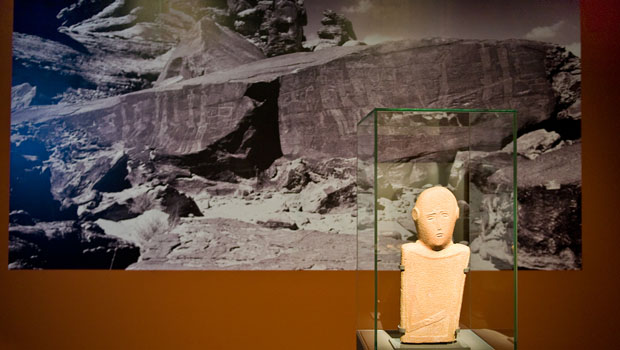Whilst its modern history — the last 14 centuries or so — has been defined by Islam, the earlier history of the Arabs and in particular, the Arabian Peninsula is rich and varied. The exhibition invites visitors to travel back six millennia or more with artefacts on show that demonstrate the richness of culture and artisanship that have existed in “Felix Arabia” from the dawn of civilization.
The range of exhibits is huge, the number — about 300 — large enough to be representative yet of a scale for the visitor to appreciate but not be overwhelmed. The massive 19-meter long photograph at the entrance to the Napoleon Hall of the desert near Al-Ula and Madain Saleh, whence many of the exhibits originate, sets the scale of the historical canvas against which the history is mounted. The work of Humberto da Silveira, who also provided images and research for photographs in the exhibition, it poses the founding contradiction that mystifies the lay visitor: How did such richness of cultures originate in such a bleak and hostile area? The title of the exhibition “Roads to Arabia” signposts the visitor to the answer: Trade and Pilgrimage. From the ancient incense trail and through the later pilgrimage routes to Makkah, the area that is now Saudi Arabia has hosted incoming cultures that brought with them ideas and technology. Each left behind traces of their existence and the exhibition brings them together for the first time outside the Kingdom.
A mournful looking anthropomorphic stele from the 4th millennium BC stands in the first gallery. Set in front of a photograph of the rocky arid background characteristic of its area of origin, it places the visitor at the beginning of the exhibition’s timeline. The haunting stylized face and arm held across the body in invitation encourages the viewer to move forward; the image is profound and sensitively placed at the beginning of the historical journey ahead. An image of the stele is superimposed over da Silveira’s monumental photograph as the front cover image on the splendidly produced and detailed exhibition catalog and reminds the reader of the contradictory premise that underlies the collection.
The exhibition takes the visitor from ancient pre-Islamic times through to the Ottoman period. The Nabataean period and Madain Saleh contribute many of the pieces which are present. Carved into sandstone lintels is script that formed the basis of written Arabic. Nearby, vast statues with a distinctly Egyptian influence in their massiveness and form, stand as testament of the influence of external culture on the Al-Ula area. These are monuments from the Lihyanite kingdom that existed in Al-Ula.
Moving forward in time, intricately carved funerary stele with developing script and ornamentation track the development of written language. Developing technology in the form of metalwork – cast bronze and surprisingly elegantly wrought silver ware document the sophistication of Arabian Peninsula culture in Pre-Islamic times. The centerpiece of this period is the fabulous lion’s (or perhaps leopard’s) head found near Najran.
The centerpiece of the post-Islamic period is a door that once graced the Ka’aba. Standing in splendid isolation and artfully lit to render the detailed chasing work clearly visible, it is a fitting finale to the journey through time.
If there are flaws in the presentation, they are that many of the information signs accompanying the exhibits are in Arabic and French only and that too many of the photographic images that provide the all-important context are but projections.
Given the spread of nationalities the Louvre attracts in a year, to leave out English will exclude a large proportion of visitors from understanding the importance of the piece they look at. Moreover the superb exhibition catalogue is in French. It is a magnificent historical resource that — if also in English — would reach a much wider market, the whole point of mounting the exhibition in the first place.
Photographically, an iconic portrait of the young Abdulaziz Al-Saud, retouched and entered by da Silveira, has a kinaesthetic immediacy that projected images, by their very nature, cannot achieve. A physical picture puts the viewer in touch — literally — with the founder of the Kingdom in a way that the ephemeral projection cannot.
They are niggling details.
However as an experience and education, the exhibition is superb and is the Louvre at its very best. For anyone even remotely interested in understanding more of the history of the Kingdom it is an absolutely essential visit in that most congenial of cities, Paris.










